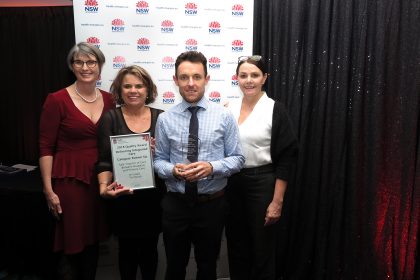
The judging panel had some tough decisions to make at this year’s NNSW LHD Quality Awards. Two Integrated Care finalists made it through to present at the Quality Awards Presentation Dinner at The Twin Towns Services Club on Friday 15 June. One of those finalists was Safe Transfer of Care between Hospitals and Primary Care, Di Goldie and Tim Marsh.
Di Goldie, Project Lead for eMR & Safe Transfer of Care, Integrated Care and Tim Marsh, Senior Manager, Information & Technology, Integrated Care submitted their project under the Category: Delivering Integrated Care with acknowledgments to the partners involved i.e. LHD Management, eHealth, GPs, Practice Staff, LHD Medical, Clinical and Administrative Staff and not least, the patients that we share care for. The presentation celebrated improvements in the Safe Transfer of Care across the NNSWLHD, through timely completion of good quality electronic Discharge Summaries (eDSs) and prompt delivery to the right GP at the right practice.
The presentation celebrated improvements in the Safe Transfer of Care across the NNSWLHD, through timely completion of good quality electronic Discharge Summaries (eDSs) and prompt delivery to the right GP at the right practice.
On attending the Quality Awards Di considered it a “wonderful opportunity to witness the patient centred professionalism and diverse projects that were presented on the night. This success was due to the willingness of staff that attended education/ read information / asked questions and documented thoroughly in eMR. Safe Transfer of Care keeps our community members safe as they transition from hospitals”.
The lack of timely delivery of quality eDSs had led to unhappy partners, GPs in particular voiced their concerns and the LHD listened which in part led to the inception of the eMR & Safe Transfer of Care project and placed focus on eDS delivery data. Both the LHD and GPs recognised the affect the issues were having on patient care, in particular continuity of care and ongoing management. There was evidence to suggest that if left unaddressed, could lead to more patient readmissions placing burden on systems.
Where to begin?
There was a need to understand what was happening with eDS completion rates, timeliness and other factors affecting eDS delivery, such as the quality of our PAS address book. When searching for some information to explain what was happening Tim and Di found that the data:
- Was difficult to find (hidden in Discern Explorer)
- Required manual generation and a lot of manipulation – hours of work each month.
- Didn’t tell the whole story
- Wasn’t visible (after all that work)
Tim likened the search to “shining a torch into the night sky”.
What was Built:
To get the data reliably and make it shareable, a fully automated dashboard was built in QlikView to see daily or monthly, what is happening with completion and timeliness and deliverability of eDSs.
The LHD now has full visibility of data in QlikView accessible by all staff. This allowed the data to be analysed to assist the eMR and Safe Transfer of Care project.
With full visibility, the project objectives were determined. Tools were established and utilised, training put in place and administered, partnerships established and information shared.
Tools:
- Junior Medical Officer pocket guide on how to do a good eDS
- Changes to Powerchart: making the adult assessment admission tool mandatory
- Distribution of the “You make a difference” pen
Education:
- For admission and registering staff about the importance of asking the patient who their current GP is including how to ask.
- About the existing transfer of care referral supplement (which provided the ability to provide a multidisciplinary discharge summary)
Partnerships:
- Working with the North Coast Primary Health Network to improve accuracy of GP contact details and other important information including a new simple webform for practices to submit updates.
- Working with eHealth and local Clinical Information Services to facilitate changes in process including changes made to Powerchart
Shared Information
The QlikView dashboard allowed for sharing of performance data with LHD Executive staff, Directors of Meicine, Junior Medical Officers, Managers and the NCPHN.

Overall Outcomes:
- Visibility of data = executive awareness of the problems and impetus for change
- GPs and NCPHN aware of improvements and perceive teh LHD as active partners in the change
- GPs are now more reliably submitting updates on GP movements using the webform
- eDS quality has improved (a survey has been sent out to GPs to quantify and qualify this)
- Multidisciplinary input to eDS improves the quality and feeling of LHD staff (discharge planners, allied health etc) being valued
- Timeliness improved
Sustainability, Transferability, Innovation
- Clinicians now see eDS completion as normal process for safe transfer of care
- Any LHD with the same data set (Cerner EMRs) can do what we did
- Highly innovative, fully automated, easy to use, not aware of any other LHDs doing this
- Our reporting updates automatically and scales for new hospitals, Drs, Wards, etc
- A number of measures identified to further improve PAS address book quality (work for next 12-24 months)
- A priority remains ensuring we have systems and resources to support high quality, easily updated, eHealth systems and information
